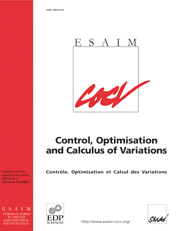Article contents
Dubins' problem is intrinsically three-dimensional
Published online by Cambridge University Press: 15 August 2002
Abstract
In his 1957 paper [1] L. Dubins considered the problem of finding shortest differentiable arcs in the plane with curvature bounded by a constantand prescribed initial and terminal positions and tangents. One can generalize this problem to non-euclidean manifolds as well as to higherdimensions (cf. [15]). Considering that the boundary data - initial and terminal position and tangents - are genuinely three-dimensional, it seems natural to ask if then-dimensional problem always reduces to the three-dimensional case. In this paper we will prove that this is true in the euclidean as well as inthe noneuclidean case. At first glance one might consider this a trivial problem, but we will also give an example showing that this is not thecase.
Keywords
Information
- Type
- Research Article
- Information
- Copyright
- © EDP Sciences, SMAI, 1998
- 9
- Cited by

